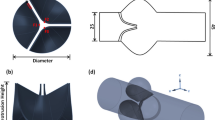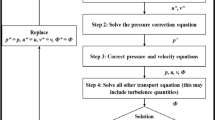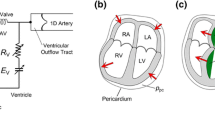Abstract
Blood flow through the ascending aorta of two individuals is studied numerically. Realistic flow simulation is enabled by the combination of MRI and CFD. The aim of this study is the validation of the calculated flow field and, on the other hand, a comparison between flow distal to an artificial heart valve and native flow of a healthy volunteer. Three-dimensional, time-dependent computer models of the human ascending aorta were reconstructed from three-directional data sets acquired by MRI in the subjects studied. MRI velocity measurements downstream of the aortic valve provided the inflow conditions for the computational study. The pulsatile flow is described by the ALE-modified Navier-Stokes equations with respect to the time-varying flow domain. The numerical approach applies our own developed finite-element solver. During systolic acceleration the flow patterns distal to the valves do not show major differences between the two configurations. During flow deceleration, however, a significant influence of the disturbed inflow conditions can be found in the whole segment. Using the methods proposed, simulation of blood flow in the ascending aorta of the two subjects could be successfully performed. There was good qualitative agreement of blood velocities predicted by CFD and velocity data measured by MRI. In conclusion, the approach described herein might offer a new way towards an improved assessment of detailed in vivo flow conditions and alterations of blood flow associated with heart valve prostheses in particular. Combining CFD and MRI potentially extends the quantification of hemodynamic variables in vivo at a scale beyond the resolution limit inherent to MRI.
Similar content being viewed by others
References
K.B. Chandran, Flow dynamics in the human aorta. J. Biomech. Engng. 115 (1993) 611–616.
R.M. Nerem, Hot-film measurements of arterial blood flow and observations of flow disturbances. In: N.H.C. Hwang and N.A. Norman (eds.), Cardiovascular Flow Dynamics and Measurements. Baltimore/London/Tokyo: University Park Press (1977) pp. 191–215.
M.H. Friedman. Geometric risk factors for arteriosclerosis. Arteriosclerosis 4 (1983) 85–94.
S.A. Berger, L. Talbot and L.S. Yao, Flow in curved tubes. Ann. Rev. Fluid Mech. 15 (1983) 461–512.
K. Ohba, H. Kamino, T. Urabe and S. Ikedo, Pulsatile flow through a tapered U-bend as simulated aortic arch (flow characteristics and velocity field). In: R.A. Gerbsch and K. Ohba (eds.), Proc. ASME FED Symposium on BioMedical Fluids Engineering, volume 212. Hilton Head, South Carolina (1995) pp. 23–28.
S. Jin, J. Oshinski and D. Giddens, Effects of inflow conditions and wall motion on flow in the ascending aorta. In: R.D. Kamm, G.W. Schmid-Schönbein, G.A. Ateshian, and M.S. Hefzy (eds), Proc. 2001 Bioengineering Conference, volume BED-Vol. 50. New York: ASME (2001) pp. 13–14.
D. Mori and T. Yamaguchi, Computational fluid dynamics modeling and analysis of the 3-d distortion of the human aortic arch. Comput. Meth. Biomech. Biomed. Engng. 5 (2002) 249–260.
A. Leuprecht, K. Perktold, S. Kozerke and P. Boesiger, Combined CFD and MRI study of blood flow in a human ascending aorta model. Biorheology 39 (2002) 425–429.
S.J. Weston, N.D. Wood, G. Tabor, A.D. Gosman and D.N. Firmin, Combined MRI and CFD analysis of fully developed steady and pulsatile laminar flow through a bend. J. Magn. Reson. Imag. 8 (1998) 1158–1171.
J.A. Moore, D.A. Steinman, D.W. Holdsworth and C.R. Ethier, Accuracy of computational hemodynamics in complex arterial geometries reconstructed from magnetic resonance imaging. Ann. Biomed. Engng. 27 (1999) 32–41.
Q. Long, X.Y. Xu, M. Bourne and T.M. Griffith, Numerical study of blood in an anatomically realistic aorto-iliac bifurcation generated from MRI data. Magn. Reson. Med. 43 (2000) 565–576.
F.P. Glor, J.J.M. Westenberg, J. Vierendeels, M. Danilouchkine and P. Verdonck, Validation of the coupling of magnetic resonance imaging velocity measurements with computational fluid dynamics in a U bend. Artificial Organs 26 (2002) 622–635.
Y.R. Woo and A.A. Yoganathan, In vitro pulsatile flow velocity and turbulent shear stress measurements in the vicinity of mechanical aortic heart valve prostheses. Life Support Syst. 3 (1985) 283–312.
J.M. Hasenkam, E.M. Pedersen, J.H. Ostergaard, H. Nygaard, P.K. Paulsen, G. Johannsen and B.A. Schurizek, Velocity fields and turbulent stresses downstream of biological and mechanical aortic valve prostheses implanted in pigs. Cardiovasc. Res. 22 (1988) 472–483.
M. Giersiepen, L.J. Wurzinger, R. Opitz and H. Reul, Estimation of shear stress-related blood damage in heart valve prostheses-in vitro comparison of 25 aortic valves. Int. J. Artif. Organs 13 (1990) 300–306.
T.J.R. Hughes, W.K. Liu and T.K. Zimmermann, Lagrangian-Eulerian finite element formulation in incompressible viscous flows. Comput. Methods Appl. Mech. Engng. 29 (1981) 329–349.
K. Boukir, B. Nitrosso and B. Maury, A characteristics-ALE method for variable domain Navier-Stokes equations. In: L.C. Wrobel, B. Sarler, and C.A. Brebbia (eds.), Computational Modelling of Free and Moving Boundary Problems III. Southampton/Boston: Comput. Mech. Publ. (1995) pp. 57–65.
A. Quarteroni and L. Formaggia, Mathematical modelling and numerical simulation of the cardiovascular system. MOX-Report No. 01 (2002).
S. Kozerke, J.M. Hasenkam, H. Nygaard, P.K. Paulsen, E.M. Pedersen and P. Boesiger, Heart motion adapted MR velocity mapping of blood velocity distribution downstream of aortic valve prostheses: initial experience. Radiology 218 (2001) 548–555.
S. Kozerke, M.B. Scheidegger, E.M. Pedersen and P. Boesiger, Heart motion adapted cine phase-contrast flow measurements through the aortic valve. Magn. Reson. Med. 42 (1999) 970–978.
P. Dierckx. Curve and Surface Fitting with Splines. Oxford/New York/Tokyo: Clarendon Press (1993), 285 pp.
C. Reinsch, Smoothing by spline functions. Numerische Mathematik 10 (1967) 177–183.
J. Donea, Arbitrary Lagrangian Eulerian finite element methods. In: T. Belytschko and T. Hughes (eds.), Computational Methods for Transient Analysis. Volume 1 of Computational Methods in Mechanics. Amsterdam: North-Holland, Elsevier (1983) pp. 474–515.
A. Quarteroni, M. Tuveri, and A. Veneziani, Computational vascular fluid dynamics. Problems, models and methods. Comput. Visualisation Sci. 2 (2000) 163–197.
L. Formaggia and F. Nobile, A stability analysis for the arbitrary Lagrangian Eulerian formulation with finite elements. East West J. Num. Math. 7 (1999) 105–131.
R. Aris, Vectors, Tensors, and the Basic Equations of Fluid Mechanics. Englewood Cliffs, N.J.: Prentice Hall (1962) 286 pp.
L.E. Malvern, Introduction to the Mechanics of a Continuum Medium. Englewood Cliffs, N.J.: Prentice Hall (1969) 713 pp.
A.N. Brooks and T.J.R. Hughes, Streamline upwind/Petrov Galerkin formulations for convection dominated flows with particular emphasis on incompressible Navier-Stokes equations. Comput. Meth. Appl. Mech. Engng. 32 (1982) 199–259.
K. Perktold and G. Rappitsch, Mathematical modeling of local arterial flow and vessel mechanics. In: J. Crolet and R. Ohayon (eds.), Computational Methods for Fluid Structure Interaction, New York: Wiley (1994) pp. 230–245.
K. Perktold and G. Karner, Computational principles and models of hemodynamics. In: M. Hennerici and S. Meairs (eds.), Cerebrovascular Ultrasound Theory, Practice and Future Developments. Cambridge University Press (2001) pp. 63–76.
V. Girault and P.-A. Raviart, Finite Element Methods for Navier-Stokes Equations. Berlin/Heidelberg/New York/Tokyo: Springer (1986) 374 pp.
A.J. Chorin, Numerical solution of the Navier Stokes Equations. Math. Comput. 22 (1968) 745–762.
R. Temam, Sur l'approximation de la solution des équations de Navier-Stokes par la méthode de pas fractionnaires (II). Arch. Rat. Mech. Anal. 33 (1969) 377–385.
K. Perktold, On numerical simulation of three-dimensional physiological flow problems. Ber. Math.-Stat. Sektion, Forschungsgesellschaft Joanneum Graz. (Nr. 280/5) (1987).
K. Perktold, M. Resch, and H. Florian, Pulsatile non-Newtonian flow characteristics in a three-dimensional human carotid artery bifurcation model. Trans ASME J. Biomech. Engng. 113 (1991) 464–475.
G. Karner, K. Perktold, M. Hofer and D. Liepsch, Flow characteristics in an anatomically realistic compliant carotid artery bifurcation model. Comput. Meth. Biomech. Biomed. Engng. 2 (1999) 171–185.
M. Hofer and K. Perktold, Vorkonditionierter konjugierter Gradienten Algorithmus für groβe schlecht konditionierte unsymmetrische Gleichungssysteme. Supplement Volume Z. angew. Math. Mech. 75 SII (1995) 641–642.
D.N. Ku, D.P. Giddens, C.K. Zarins and S. Glagov, Pulsatile flow and atherosclerosis in the human carotid bifurcation. Positive correlation between plaque location and low oscillating shear stress. Arteriosclerosis 5 (1985) 293–302.
Author information
Authors and Affiliations
Rights and permissions
About this article
Cite this article
Leuprecht, A., Kozerke, S., Boesiger, P. et al. Blood flow in the human ascending aorta: a combined MRI and CFD study. Journal of Engineering Mathematics 47, 387–404 (2003). https://doi.org/10.1023/B:ENGI.0000007969.18105.b7
Issue Date:
DOI: https://doi.org/10.1023/B:ENGI.0000007969.18105.b7




